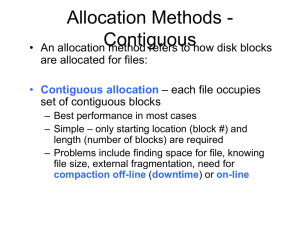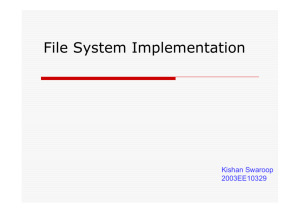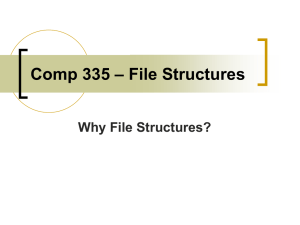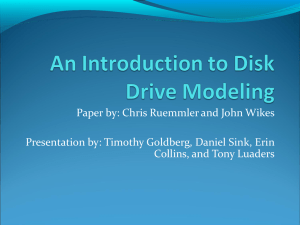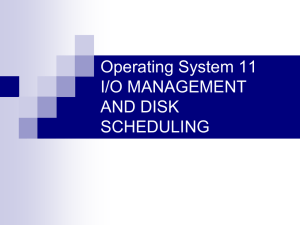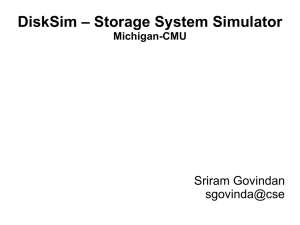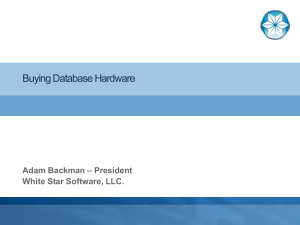Lectures 25 and 26
advertisement
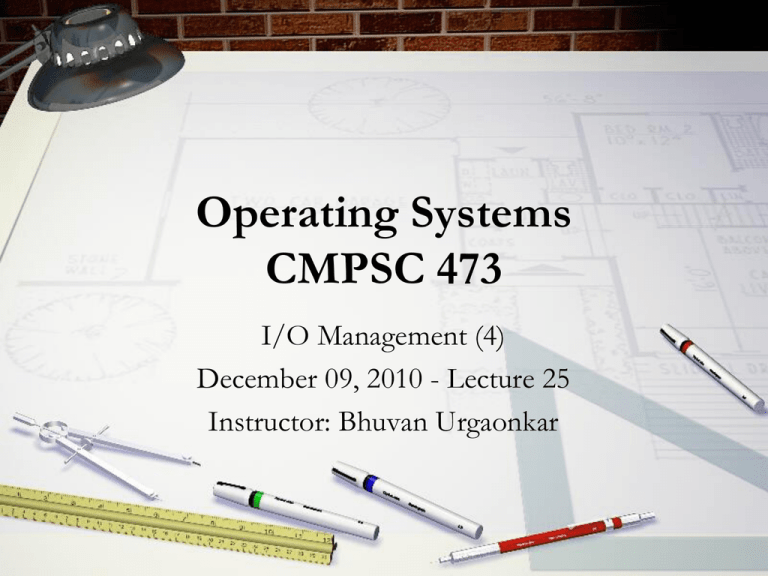
Operating Systems CMPSC 473 I/O Management (4) December 09, 2010 - Lecture 25 Instructor: Bhuvan Urgaonkar CPU/Memo Sub-system Disk Scheduling • Ordering of requests issued to disk – In OS: Device driver: order requests sent to controller – In controller: order requests executed by disk arm • Typical goal: Minimize seek time (our focus) – Seek time dependent on seek distance • More advanced – Incorporate rotational latency as well – Incorporate notions of fairness Disk Scheduling (Cont.) • Several algorithms exist to schedule servicing of disk I/O requests. • We illustrate them with a request queue (0-199). 98, 183, 37, 122, 14, 124, 65, 67 Head pointer 53 FCFS Illustration shows total head movement of 640 cylinders. SSTF • Selects the request with the minimum seek time from the current head position. • SSTF scheduling is a form of SJF scheduling; may cause starvation of some requests. • Illustration shows total head movement of 236 cylinders. SSTF (Cont.) SCAN • The disk arm starts at one end of the disk, and moves toward the other end, servicing requests until it gets to the other end of the disk, where the head movement is reversed and servicing continues. • Sometimes called the elevator algorithm. • Illustration shows total head movement of 208 cylinders. SCAN (Cont.) C-SCAN • Provides a more uniform wait time than SCAN. • The head moves from one end of the disk to the other. servicing requests as it goes. When it reaches the other end, however, it immediately returns to the beginning of the disk, without servicing any requests on the return trip. • Treats the cylinders as a circular list that wraps around from the last cylinder to the first one. C-SCAN (Cont.) C-LOOK • Version of C-SCAN • Arm only goes as far as the last request in each direction, then reverses direction immediately, without first going all the way to the end of the disk. C-LOOK (Cont.) File-System Structure • File structure – Logical storage unit – Collection of related information • File system resides on secondary storage (disks) • File system organized into layers • File control block – storage structure consisting of information about a file Layered File System A Typical File Control Block In-Memory FS Structures • Opening a file • Reading a file File-System Structure • File structure – Logical storage unit – Collection of related information • File system resides on secondary storage (disks) • File system organized into layers • File control block – storage structure consisting of information about a file Virtual File Systems • Virtual File Systems (VFS) provide an objectoriented way of implementing file systems. • VFS allows the same system call interface (the API) to be used for different types of file systems. • The API is to the VFS interface, rather than any specific type of file system. Schematic View of Virtual File System Directory Implementation • Linear list of file names with pointer to the data blocks. – simple to program – time-consuming to execute • Hash Table – linear list with hash data structure. – decreases directory search time – collisions – situations where two file names hash to the same location – fixed size Allocation Methods • An allocation method refers to how disk blocks are allocated for files: • Contiguous allocation • Linked allocation • Indexed allocation Contiguous Allocation • Each file occupies a set of contiguous blocks on the disk • Simple – only starting location (block #) and length (number of blocks) are required • Wasteful of space (dynamic storage-allocation problem) • Files cannot grow Contiguous Allocation of Disk Space Linked Allocation • Each file is a linked list of disk blocks: blocks may be scattered anywhere on the disk. block = pointer Linked Allocation (Cont.) • Simple – need only starting address • Free-space management system – no waste of space • Mapping Q LA/508 R Block to be accessed is the Qth block in the linked chain of blocks representing the file. Displacement into block = R + 4 File-allocation table (FAT) – disk-space allocation used by MS-DOS and OS/2. Linked Allocation File-Allocation Table Indexed Allocation • Brings all pointers together into the index block. • Logical view: index table Example of Indexed Allocation Indexed Allocation (Cont.) • Need index table • Random access • Dynamic access without external fragmentation, but have overhead of index block. • Mapping from logical to physical in a file of maximum size of 256K words and block size of 512 words. We need only 1 block for index table. Q LA/512 R Q = displacement into index table R = displacement into block Indexed Allocation – Mapping (Cont.) • Mapping from logical to physical in a file of unbounded length (block size of 512 words). • Linked scheme – Link blocks of index table (no limit on size). Q1 LA / (512 x 508) R1 Q1 = block of index table R1 is used as follows: Q2 R1 / 512 R2 Q2 = displacement into block of index table R2 displacement into block of file: Indexed Allocation – Mapping (Cont.) • Two-level index (maximum file size is 5123) Q1 LA / (512 x 512) R1 Q1 = displacement into outer-index R1 is used as follows: Q2 R1 / 512 R2 Q2 = displacement into block of index table R2 displacement into block of file Indexed Allocation – Mapping (Cont.) outer-index index table file Combined Scheme: UNIX (4K bytes per block) Free-Space Management • Bit vector (n blocks) 0 1 2 n-1 bit[i] = … 0 block[i] free 1 block[i] occupied Block number calculation (number of bits per word) * (number of 0-value words) + offset of first 1 bit • Free-Space Management (Cont.) Bit map requires extra space – Example: block size = 212 bytes disk size = 230 bytes (1 gigabyte) n = 230/212 = 218 bits (or 32K bytes) • Easy to get contiguous files • Linked list (free list) – Cannot get contiguous space easily – No waste of space Linked Free Space List on Disk Efficiency and Performance • Efficiency dependent on: – disk allocation and directory algorithms – types of data kept in file’s directory entry • Performance – disk cache – separate section of main memory for frequently used blocks – free-behind and read-ahead – techniques to optimize sequential access – improve PC performance by dedicating section of memory as virtual disk, or RAM disk Page Cache • A page cache caches pages rather than disk blocks using virtual memory techniques • Memory-mapped I/O uses a page cache • Routine I/O through the file system uses the buffer (disk) cache • This leads to the following figure I/O W/O a Unified Buffer Cache Unified Buffer Cache • A unified buffer cache uses the same page cache to cache both memory-mapped pages and ordinary file system I/O I/O Using a Unified Buffer Cache
